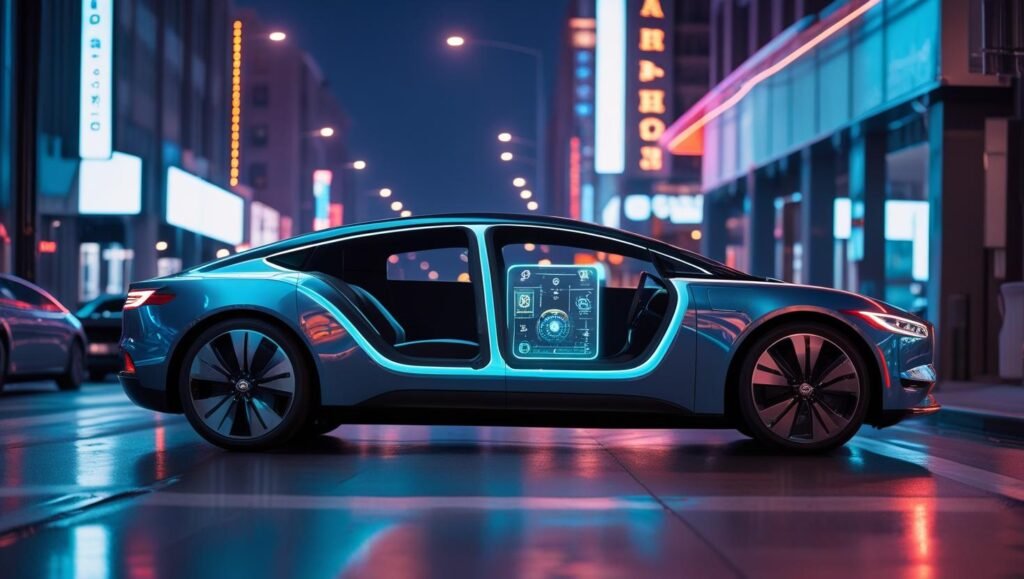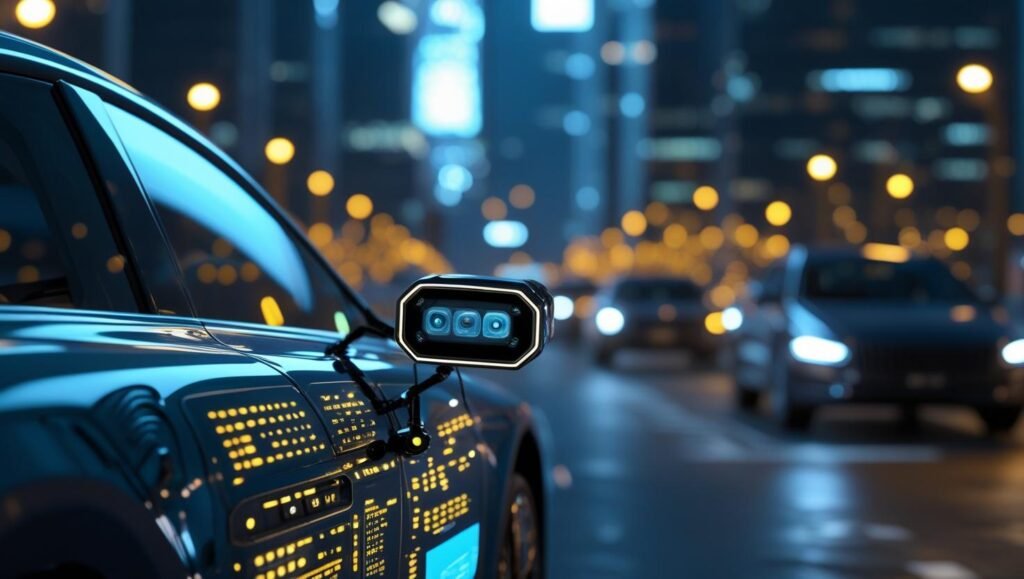AI in Autonomous Vehicles: How Artificial Intelligence Is Driving the Future of Transportation

The dawn of a new era in transportation is upon us, and at the forefront is artificial intelligence, revolutionizing the way we think about travel. Autonomous vehicles are not just a futuristic dream anymore; they are becoming an integral part of our roads and lives. With advancements in machine learning, computer vision, and real-time data processing, AI is driving innovations that promise to enhance safety, efficiency, and convenience on our daily commutes.
From reducing traffic congestion to minimizing accidents, the impact of AI in autonomous vehicles is profound and far-reaching. As we navigate this groundbreaking transformation, it’s essential to understand how these intelligent systems are reshaping our cities and the future of transportation itself.
Buckle up as we explore how artificial intelligence is steering us into a brave new world of mobility.
The Role of Artificial Intelligence in Self-Driving Technology
The development of self-driving technology has been one of the most significant advancements in the transportation sector, and at the heart of this innovation is artificial intelligence (AI). AI plays a critical role in enabling vehicles to navigate roads, interpret surroundings, and make decisions without human intervention. By using sophisticated algorithms, AI can process vast amounts of data from various sensors and cameras embedded in the vehicle, allowing it to understand and react to dynamic driving environments.
One of the primary functions of AI in autonomous vehicles is perception, which involves recognizing objects, pedestrians, and other vehicles on the road. This is achieved through computer vision, a subset of AI that enables machines to interpret and process visual data. By employing deep learning techniques, AI systems can identify and categorize objects with remarkable accuracy, even in challenging conditions such as poor weather or low light. This capability is crucial for ensuring the safety and reliability of self-driving cars.
Another essential aspect of AI in autonomous vehicles is decision-making. AI systems analyze real-time data to determine the best course of action, whether it’s changing lanes, stopping at a traffic light, or navigating through complex intersections. These decisions are based on a combination of pre-programmed rules, machine learning models, and predictive analytics. By continually learning from new data, AI systems can improve their decision-making processes over time, leading to more efficient and safer driving experiences.
Key Technologies Behind Autonomous Vehicles

The successful implementation of autonomous vehicles relies on a combination of advanced technologies that work together seamlessly. One of the key technologies is machine learning, which enables vehicles to learn from data and improve their performance over time. Machine learning algorithms are trained on vast datasets, including images, videos, and sensor data, to recognize patterns and make predictions. This training allows autonomous vehicles to handle a wide range of driving scenarios with greater accuracy and reliability.
Another critical technology is computer vision, which allows vehicles to interpret and understand their surroundings. By using cameras and sensors, autonomous vehicles can capture real-time images and videos of the road and its environment. Computer vision algorithms then process this data to identify objects, detect lane markings, and recognize traffic signals. This information is essential for the vehicle to navigate safely and make informed decisions. Advances in computer vision have significantly improved the ability of autonomous vehicles to perceive and respond to their environment.
Lidar (Light Detection and Ranging) is another vital technology used in autonomous vehicles. Lidar systems use laser beams to create detailed, three-dimensional maps of the vehicle’s surroundings. These maps provide high-resolution data on the position and distance of objects, which is crucial for accurate navigation and obstacle avoidance. Unlike cameras, Lidar systems are not affected by lighting conditions, making them highly reliable in various driving environments. The integration of Lidar with AI and other sensors enhances the overall perception capabilities of autonomous vehicles.
Benefits of AI in Transportation Safety and Efficiency
The integration of AI in autonomous vehicles offers numerous benefits, particularly in terms of safety and efficiency. One of the most significant advantages is the potential to reduce traffic accidents caused by human error. According to the National Highway Traffic Safety Administration (NHTSA), human error is a factor in approximately 94% of traffic accidents. Autonomous vehicles equipped with AI systems can significantly reduce these errors by consistently adhering to traffic rules, maintaining safe distances, and reacting quickly to unexpected situations.
AI also enhances transportation efficiency by optimizing driving patterns and reducing congestion. Autonomous vehicles can communicate with each other and with traffic infrastructure to coordinate movements and avoid bottlenecks. This vehicle-to-everything (V2X) communication enables more efficient use of road space and smoother traffic flow. Additionally, AI can optimize routes based on real-time traffic data, reducing travel times and fuel consumption. By minimizing idling and unnecessary stops, autonomous vehicles contribute to lower emissions and a more sustainable transportation system.
Another benefit of AI in transportation is the potential to improve accessibility and mobility for various populations, including the elderly and individuals with disabilities. Autonomous vehicles can provide a safe and reliable means of transportation for those who may have difficulty driving themselves. This increased accessibility can enhance the quality of life for many people, providing greater independence and opportunities for social and economic engagement. The convenience and inclusivity offered by autonomous vehicles have the potential to transform urban mobility and create more equitable transportation systems.
Challenges Facing AI in Autonomous Vehicle Development

Despite the significant advancements in AI and autonomous vehicle technology, several challenges remain in the development and deployment of self-driving cars. One of the primary challenges is ensuring the safety and reliability of AI systems in diverse and unpredictable driving environments. While AI systems can handle many scenarios, they may struggle with rare or complex situations that are difficult to anticipate. Ensuring that autonomous vehicles can safely navigate these edge cases requires extensive testing, validation, and continuous improvement of AI algorithms.
Another challenge is the integration of autonomous vehicles with existing transportation infrastructure. Many current road systems are designed for human drivers and may not be fully compatible with autonomous vehicles. Upgrading infrastructure to support V2X communication, improving road markings, and developing dedicated lanes for self-driving cars are some of the measures needed to facilitate the integration of autonomous vehicles. These infrastructure changes require significant investment and coordination among various stakeholders, including governments, transportation agencies, and private companies.
Ethical considerations also pose challenges in the development of autonomous vehicles. AI systems must be programmed to make decisions that align with societal values and ethical principles. For example, in situations where an accident is unavoidable, how should an autonomous vehicle prioritize the safety of its passengers versus pedestrians? Addressing these ethical dilemmas requires careful consideration and collaboration among ethicists, engineers, policymakers, and the public. Developing transparent and accountable AI decision-making processes is essential for gaining public trust and acceptance of autonomous vehicles.
Case Studies: Successful Implementation of AI in Autonomous Vehicles
Several companies and organizations have made significant strides in the successful implementation of AI in autonomous vehicles. Waymo, a subsidiary of Alphabet Inc., is one of the leading players in the field. Waymo’s self-driving technology has undergone extensive testing and real-world deployment, accumulating millions of miles of autonomous driving experience. The company’s AI-powered vehicles have been tested in various cities and driving conditions, demonstrating their ability to navigate complex urban environments safely. Waymo’s commitment to rigorous testing and continuous improvement has positioned it as a frontrunner in the autonomous vehicle industry.
Tesla is another prominent player in the autonomous vehicle space, leveraging AI to enhance its Autopilot and Full Self-Driving (FSD) systems. Tesla’s approach combines computer vision, neural networks, and real-time data processing to enable semi-autonomous and fully autonomous driving capabilities. The company’s extensive fleet of vehicles on the road provides valuable data for training and refining its AI systems. Tesla’s iterative development process and over-the-air software updates allow for continuous improvement and the rapid deployment of new features, making significant contributions to the advancement of autonomous driving technology.
In the realm of public transportation, the city of Pittsburgh has been a pioneer in testing autonomous shuttles through partnerships with companies like Argo AI and the local government. These pilot programs aim to assess the feasibility and safety of autonomous shuttles in urban environments. By utilizing AI to navigate predefined routes, these shuttles offer a glimpse into the future of public transportation, where AI-driven vehicles can provide efficient and reliable mobility solutions. The successful implementation of these pilot programs highlights the potential of AI to transform urban transportation and improve accessibility for city residents.
AI and Autonomous Vehicles: What lies ahead

As AI continues to evolve, several trends are shaping the future of autonomous vehicles. One notable trend is the increasing focus on developing Level 5 autonomy, where vehicles can operate without any human intervention under all conditions. Achieving Level 5 autonomy requires significant advancements in AI, sensor technology, and regulatory frameworks. Companies are investing heavily in research and development to overcome the technical challenges and bring fully autonomous vehicles to market. The pursuit of Level 5 autonomy represents the ultimate goal of creating vehicles that can navigate any environment independently.
Another emerging trend is the integration of AI with other advanced technologies, such as 5G connectivity and the Internet of Things (IoT). The combination of AI, 5G, and IoT enables real-time communication and data exchange between vehicles, infrastructure, and other devices. This connectivity allows for more efficient traffic management, predictive maintenance, and enhanced safety features. The synergy between these technologies has the potential to create a highly interconnected and intelligent transportation ecosystem, where autonomous vehicles can operate seamlessly and efficiently.
The rise of shared autonomous mobility services is also a significant trend to watch. Ride-hailing companies and mobility-as-a-service (MaaS) providers are exploring the deployment of autonomous vehicles for shared transportation. These services aim to reduce the number of privately-owned vehicles on the road, alleviate congestion, and provide cost-effective and convenient transportation options. As autonomous vehicle technology matures, the adoption of shared mobility services is expected to increase, leading to more sustainable and efficient urban transportation systems.
The Impact of Autonomous Vehicles on Urban Planning and Infrastructure
The advent of autonomous vehicles is expected to have a profound impact on urban planning and infrastructure. One of the key changes will be the redesign of roadways and traffic management systems to accommodate self-driving cars. Dedicated lanes for autonomous vehicles, intelligent traffic signals, and enhanced V2X communication infrastructure are some of the modifications needed to support the integration of autonomous vehicles. These changes will require significant investment and collaboration between governments, urban planners, and technology providers to create infrastructure that facilitates the safe and efficient operation of autonomous vehicles.
The widespread adoption of autonomous vehicles also has the potential to transform land use and urban development. With the reduced need for parking spaces, urban areas can be reimagined to prioritize green spaces, pedestrian zones, and mixed-use developments. Autonomous vehicles can be designed to drop off passengers and continue to new destinations, eliminating the need for extensive parking facilities. This shift can lead to more sustainable and livable cities, where space is optimized for people rather than cars. Urban planners must consider these possibilities when designing future cities to maximize the benefits of autonomous vehicle technology.
Public transportation systems are likely to be significantly impacted by the introduction of autonomous vehicles. Autonomous shuttles and buses can provide efficient and flexible transportation options, reducing the reliance on traditional fixed-route services. These autonomous public transportation solutions can enhance accessibility and connectivity, particularly in underserved areas. Integrating autonomous vehicles with existing public transportation networks can create a seamless and multimodal transportation system that offers greater convenience and efficiency for urban residents. The impact of autonomous vehicles on urban planning and infrastructure will be transformative, shaping the future of cities and mobility.
Conclusion:
The journey towards fully autonomous vehicles is an exciting and transformative one, driven by the remarkable advancements in artificial intelligence. As AI continues to evolve, it is revolutionizing the transportation sector by enhancing safety, efficiency, and convenience. The integration of machine learning, computer vision, and real-time data processing is enabling vehicles to navigate complex environments and make intelligent decisions without human intervention. The benefits of AI in autonomous vehicles are profound, from reducing accidents caused by human error to optimizing traffic flow and improving accessibility for all.
However, the path to widespread adoption of autonomous vehicles is not without its challenges. Ensuring the safety and reliability of AI systems, addressing regulatory and ethical considerations, and upgrading infrastructure are some of the critical hurdles that need to be overcome. Collaboration among governments, industry stakeholders, researchers, and the public is essential to address these challenges and create a supportive ecosystem for autonomous vehicles. Developing robust regulatory frameworks, ethical guidelines, and cybersecurity measures will be crucial for gaining public trust and ensuring the responsible deployment of AI in transportation.
As we look to the future, the potential of AI in autonomous vehicles is boundless. The continued advancements in AI, coupled with the integration of emerging technologies like 5G and IoT, will pave the way for fully autonomous and interconnected transportation systems. The rise of shared autonomous mobility services and the transformation of urban planning and infrastructure will create more sustainable, efficient, and livable cities. The road ahead for AI in autonomous vehicles is filled with promise, and as we embark on this journey, we are steering towards a future where intelligent systems drive the next generation of mobility.
For the latest insights and updates, be sure to explore our AI Trends & News and stay ahead in the world of artificial intelligence.
